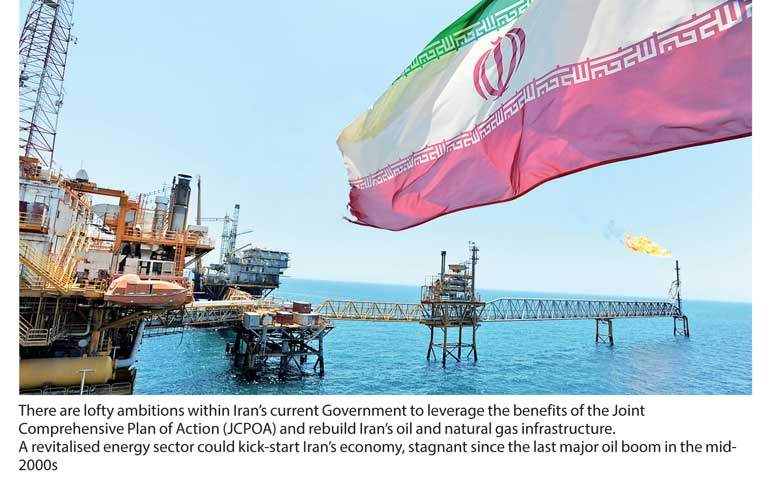Monday Dec 22, 2025
Monday Dec 22, 2025
Tuesday, 26 September 2017 00:00 - - {{hitsCtrl.values.hits}}
 Dr. Mohamed Shareef Asees
Dr. Mohamed Shareef Asees
Economic sanctions are not a new phenomenon to Iran. It has been 38 years since the Iranian revolution (1979) took place. Since then, the United States, European Union and some other countries have been imposing sanctions against Iran which, in turn have significantly affected the Iranian economy.
US sanctions against Iran refer to economic, trade, scientific and military sanctions against Iran, which have been imposed by the US Office of Foreign Assets Control, or by the international community under US pressure through the United Nations Security Council.
The sanctions have been effective due in large part to the multi-lateral approach and the focus on closing down the ability of Iran to sell major export products, such as oil, gas, metals and petro-chemicals and to conduct money transactions globally through major financial networks. The last economic sanction was imposed against Iran in 2012 however it got lifted in July 2015.
Economic sanctions are commercial and financial penalties applied by one or more countries against a targeted country, group, or individual. Economic sanctions may include various forms of trade barriers, tariffs, and restrictions on financial transactions.
Economic sanctions are not necessarily imposed because of economic circumstances, sometimes they may also be imposed for a variety of political, military, social and cultural issues. Economic sanctions can be used for achieving domestic and international purposes. In other words economic sanction is a tool where some powerful countries use this to achieve their national interests (exploit natural resources) and punish certain country or group of people or individual for not tolerating with their demands.
Iran and oil
Iran is one of the biggest oil producing countries in the Middle Eastern region. It produces around 5-6% crude oil in the world. Around 80% of income comes from crude oil to Iran. Oil was first discovered in Iran in 1908, in the south-western province of Khuzestan. By the 1920s, the national oil industry had matured, an enormous refinery had been built in Abadan on the Persian Gulf, and Iran was among the top five oil producers in the world, accounting for 5-6% of world production (Ferrier, 1982).
Yet the industry was owned and operated by a British firm, the Anglo-Iranian Oil Company, and the bulk of the oil  revenues were shared between the British Government and Oil Company, with only a small percentage paid to Iran as a royalty/monarchs. This situation came to a head during the 1951-53 oil nationalisation crises, when Iranian Prime Minister Mohammed Mossadegh nationalised the country’s oil industry, ejecting the British technicians from Abadan and setting off a world-wide oil crisis (Ibid. 1982).
revenues were shared between the British Government and Oil Company, with only a small percentage paid to Iran as a royalty/monarchs. This situation came to a head during the 1951-53 oil nationalisation crises, when Iranian Prime Minister Mohammed Mossadegh nationalised the country’s oil industry, ejecting the British technicians from Abadan and setting off a world-wide oil crisis (Ibid. 1982).
Some historians, including prominent Iranian scholar Ervand Abrahamian, have argued that control over oil was the primary reason the United States and Great Britain plotted to overthrow Mossadegh in the infamous coup of August 1953 (Ervand Abrahamian, 2013:9). The regime of the Shah Mohammed Reza Pahlavi that succeeded Mossadegh made energy production a major focus of Iran’s economy.
After the 1973 oil crisis and the quadrupling (increased fourfold) of the oil price, Iran began to earn enormous revenues from its oil production, much of it funnelled into modernisation, industrialisation and militarisation programs. Production peaked in 1974 at six million barrel per day-bpd (Karshenas, 1990).
Yet the massive influx of oil-based wealth de-stabilised the Iranian economy, accelerating inflation and exacerbating a mid-1970s downturn that provided part of the impetus for the ousting of the Shah in 1979 and the rise of the Islamic Republic (Abrahamian, 2013). The Islamic Revolution (1979) in Iran, as well as strikes within Iran’s oil fields, caused Iranian oil production to plummet/fall to two million bpd (Ibid. 2013).
Today, Iran produces roughly 3.6 million barrels per day (bpd), down from a pre-2012 peak of 4.3 million in 2011. Sanctions in place since 2012 have cut Iran’s oil production in half. It exports a much smaller percentage of its production due to the rise of domestic demand. In 2014, Iran exported only 1.1 million bpd according to OPEC figures. Natural gas is another major source of income to Iran. According to the Iran’s Petroleum Ministry, the proved natural gas reserves of Iran are about 1,201 trillion cubic feet or about 17.8% of world’s total reserves, of which 33% are as associated gas and 67% is in non-associated gas fields (Abrahamian. 2015).
Lofty ambitions
There are lofty ambitions within Iran’s current Government to leverage the benefits of the Joint Comprehensive Plan of Action (JCPOA) and rebuild Iran’s oil and natural gas infrastructure. A revitalised energy sector could kick-start Iran’s economy, stagnant since the last major oil boom in the mid-2000s.
In a sense, it could see the return of the heady days of the 1970s, when the country was flush with oil riches and the state benefited from high oil prices and ever-expanding revenues. Yet those days carry with them the memories of the Shah’s regime, which the current rulers of Iran – even today – continue to resent as repressive, corrupt and overly Westernised.
After months of negotiations, the five permanent members of the UN Security Council (the US, UK, France, Russia, China) plus Germany (the P5+1) agreed on a set of temporary suspensions of certain sanctions in return for Iran making specific concessions on its nuclear program.
In July 2015, the US lifted the economic sanction in Iran. Since then, the US and some other European countries began their economic ties with Iran. In 2015, the US companies obtained licenses on an expedited basis to export civil aviation repair parts to Iran and to repair Iranian civil aircraft. Further Iran has signed some agreements with Germany and France too. Followings are some case studies where one can understand the trade relations between Iran and other countries.
Trade relations
Iran and US: Trade between Iran and the United States has a long history. Despite the economic sanction both countries manage to do the imports and exports under some certain conditions. According to the US State Department, US exports to Iran include cigarettes ($73 million), corn ($68 million); chemical wood pulp, soda or sulfate ($64 million); soybeans ($43 million); medical equipment ($27 million); vitamins ($18 million); and vegetable seeds ($12 million). In return, Iran exports oil, gas and Persian carpets.
According to the United States Census Bureau, American exports to Iran reached over $450 million where Iran exported $97 million to the US in the past two years. The present statistics show that there is a great improvement on trade between these two countries especially right after the sanction lifted.
Iran and Germany: German exports to Iran rose by 26% last year and by more than 30% in January alone, says an economist at Germany’s Chamber of Commerce and Industry. Germany mainly exports motor cars and machinery items to Iran where Iran exports oil and gas to Germany. President of German Chambers of Commerce Eric said that his country intends to increase trade with Iran in short-term period to five billion and in mid-term to 10 billion Euros. The above statistics show that Germany has increased its trade with Iran in the post sanction period.
Iran and France: Iranian President Hassan Rouhani has signed trade deals with France worth billions of dollars following the lifting of international sanctions imposed over its nuclear program. Iran agreed to import passenger (118) flights and few other electronic equipment from France in return Iran will export Oil and Gas. The trade relations between these two countries seem very positive and they look forward to work more in the future. Both countries agreed to issues more visas so that investors can engage on more trade activities.
Iran and UK: Trade between Iran and UK was not good in the past as both countries had some bitter experience over the Northern Ireland conflict. However, this got changed after the economic sanctions got lift. Now both countries are looking forward to increase the trade relation.
Iran and China: Trade between Iran and China soared from $4 billion in 2003 to over $20 billion in 2009. China’s major exports to Iran have been machinery and equipment, textiles, chemical products and consumer goods. A significant portion of Chinese shipments has reportedly been funnelled to Iran through China’s trade with the United Arab Emirates. China has also been selling refined gasoline to Iran, which lacks the refineries to meet its domestic needs. China and Iran agreed in last month 2017 to increase trade to $600 billion in the next ten years, as President Xi Jinping met with Iranian President Hassan Rouhani after the lifting of international sanctions.
Iran and Sri Lanka: The trade between the two countries for a long period of time is concentrated in exchange of two commodities. i.e.: Black Gold (Crude Petroleum) and Green Gold (Ceylon Tea). The total trade turnover between the two countries during the year 2009 stood at $ 1 billion representing $ 145 million exports from Sri Lanka to Iran and $ 850 million imports from Iran to Sri Lanka. The current situation of these two countries: Sri Lanka in the post conflict era and Iran in the post sanction period seems both countries have more possibility to increase the trade in the future. The above examples show that although Iran suffered due to the economic sanction still it could manage with many countries to do its imports and exports.
The overall conclusion of this article is that economic sanction is a tool which used by some powerful countries to mitigate the nuclear issues and weaken its economy. Further those countries want to exploit all oil from Iran with a cheap price and make sure not any other countries (especially developing countries) purchase from it. It seems the economic sanction is mainly between Iran and other developing countries but not with the US and other European countries.
Recent study shows that Iran has plenty of business with US and with other European countries but not with many developing countries. There is a constant fear among the developing countries that if they have any import or export with Iran it may damage their relations with US. Further many countries hesitate to do business with Iran due to the money transaction problem.
Reference
1.Ervand Abrahamian 1982. Iran between Two Revolutions
Ervand Abrahamian 2013. The Coup: 1953, the CIA, and the Roots of Modern US-Iranian Relations
2.Ervand Abrahamian 2015. A History of Modern Iran
3.Jonathan Epstein & Tom Morante. Economic Sanctions in Iran: Coping with the Changing Landscape. http://insights.ethisphere.com/economic-sanctions-in-iran/
4.Ferrier: 1982. Mercantile States and the World Oil Cartel, 1900-1939
5.Massoud Karshenas 1990. Oil, state, and industrialisation in Iran